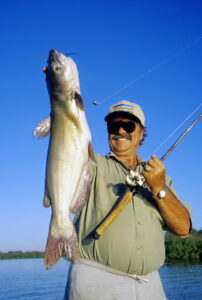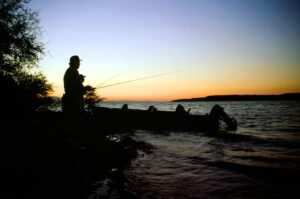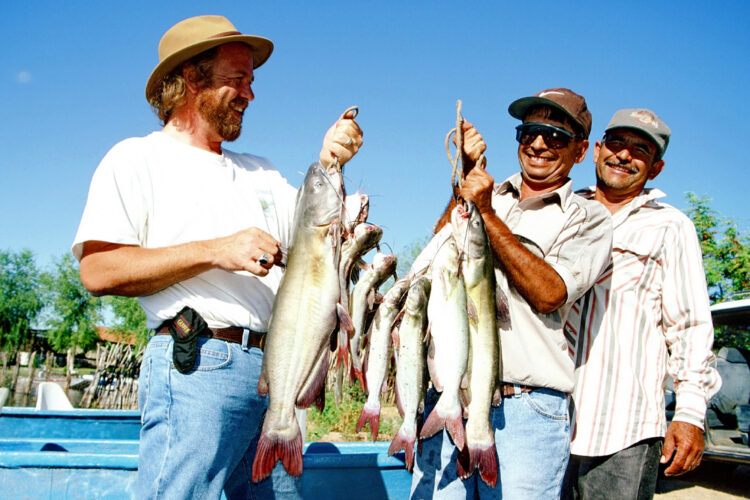Keith Sutton and his Mexican fishing friends Marcelino and Juan with a mess of catfish caught in Lake Dominguez.
South-of-the-Border Catfish
by Keith “Catfish” Sutton
So, you’ve never heard of anyone fishing for catfish in Mexico? That’s one of the things that can turn a trip south of the border into the adventure of a lifetime.
Lake Dominguez was the first body of water in Mexico to be stocked with Florida-strain largemouth bass. It was there in that 20,000-acre impoundment on the Rio Fuerte that trophy bass fishing got its start south of the border. In the late 1960s and early 1970s, U.S. bass anglers came to Dominguez in droves to catch double-digit bass in these scenic waters in western Mexico’s state of Sinaloa.
Unfortunately, in just a few years, unregulated sportfishing and overharvest by local commercial fishermen took their toll on the lake’s extraordinary bass population. Days when anglers could catch hundreds of largemouths in a few hours soon passed, and after bass were stocked in other lakes, American anglers started traveling elsewhere to experience the finest in Mexican bass angling.
Despite all this, hefty largemouths still swim the waters of Dominguez. Today, a savvy visiting angler can expect to catch around 10 to 20 nice bass daily, including, on occasion, some trophy specimens up to 12 pounds or more. And many anglers still go there to enjoy guided fishing offered by a few local outfitters who cater to U.S. anglers.
Perhaps someday you’ll have a chance to visit Lake Dominguez. If you do, here’s a fact you won’t find publicized anywhere but here: Lake Dominguez is one of the finest trophy channel catfish lakes in North America. That fact is not widely known. Indeed, until now, my late friend Bill Skinner and I may have been the only gringos who ever visited Dominguez exclusively to fish for these whiskered warriors. We were not disappointed.
Discovering Mexican Catfish
While fishing together on another popular Mexican bass lake, Huites, in 1999, Skinner, knowing I loved catfishing, asked, “How would you like to visit a lake where there are cats as long as your leg? I used to guide on Lake Dominguez, which is on the route we’ll take back to the airport. At night, while the bass anglers slept, I’d stay up and fish for catfish, and over the years, I caught some really big ones. You and I could leave early and give it a try.”
I quickly agreed, and Skinner made arrangements with two fishermen from El Fuerte, Marcelino and Juan, to take us out in a boat on Dominguez. He also arranged for them to set out a trotline before our arrival.
Dominguez Hawgs

Marcelino told us he had obtained some shad from the nearby river for bait. We cut the fresh fish into chunks and baited the 20-hook trotline. Then, while we waited to see what might bite, we motored to another portion of the lake where Juan lifted a mesh trap a friend of his had placed to catch catfish. The trap was literally stuffed with small channel cats, and a couple of 5-pounders. The larger fish were released, the smaller ones kept.
“People here do not like to eat big catfish,” Marcelino said. “They prefer smaller ones that are tastier.”
“They don’t realize it, but they’re creating a trophy catfishery by releasing all the bigger cats,” said Skinner excitedly. “Imagine how big some of these fish might be.”
We found out when we returned and ran our trotline. Several 4/0 Limerick hooks had been straightened, but a 20-pound channel cat was still hooked.
“Time to break out the rods and reels,” Skinner said as Juan boated the pot-bellied cat. And that we did. Ten minutes later, Skinner was fighting another huge channel cat, the first of several hawgs we would catch that day.
As we waited between bites, I noticed a huge dark cloud pass beneath the boat.
“What is that?” I asked.
“Tilapia fry,” said Skinner.

The little fish swam beneath us, and as I watched, I saw several big catfish in their midst, mouths opened wide so they could gorge on the bounty. One was easily twice the size of the 20-pound cat landed earlier. And as the fry passed, I saw something even more incredible. The giant cats were actually breaching as they gobbled the tilapia, their enormous heads rising out of the water as they fed. Never before have I seen such a sight.
We fished throughout the night. Several large cats got the best of us on our too-light tackle. We caught scores in the 5- to 15-pound range, but the really big specimens straightened hooks and broke line. I experienced enough to convince me, however, that Lake Dominguez harbors one of the healthiest populations of trophy channel cats on the continent. Blue cats are present in small numbers as well, and it is likely heavyweight specimens swim in this huge reservoir.
Dominguez still holds many secrets. With luck, perhaps someday I will be able to return with the proper tackle and discover more about it. In the meantime, I hope other anglers with an adventurous spirit will go there and share what they learn. I believe this beautiful lake could become one of North America’s most-visited locales for fishermen hoping to catch world-record-class channel cats.
More South-of-the-Border Cats
Mexican waters remain relatively unexplored in terms of their catfishing potential, but I have fished for catfish in several of the more popular bass lakes, and local fishermen have eagerly shared their knowledge of catfishing there. What I’ve learned indicates that channel cats, blues and flatheads have been widely stocked outside their native range in Mexico and are probably far more abundant than most people realize.
Lake Huites: Small channel cats are most abundant here, but blue catfish are present as well, including rare specimens exceeding 50 pounds. A local fisherman produced a photo of a 65-pound flathead he said was caught in the Chinipa River, which feeds the lake.
Lake Hidalgo: Hidalgo, like Huites and Dominguez, is an impoundment of the Rio Fuerte. Local anglers often travel upriver from the lake where they say huge flathead catfish, some up to 80 pounds, are common catches on trotlines.
Lake El Salto: The Elota River, which feeds this 24,000-acre Sinaloan impoundment, harbors a healthy population of blue and channel catfish, although no large specimens have yet been reported.
Lake Guerrero: On a visit to this 95,000-acre lake in the state of Tamaulipas, I saw a 72-pound blue cat caught in the net of tilapia fishermen. With little fishing pressure, a year-round growing season and a healthy forage base of tilapia, it is likely some 100-pounders could lurk there.



